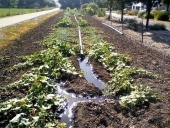posted 6 years ago
I have a few reasons:
1. build a more accurate model (DEM or similar) of the land elevation as a function of position, so as to derive contour lines, find keylines and similar.
2. determine positions of dugout boundaries at various states of fill.
3. determine positions of posts, poles and trees.
4. other stuff.
I have a handheld GPS, but it simply has to imprecise data to be more than a help with things. In order to keep the water in my body from absorbing satellite signals, I usually tape my GPS onto a baseball hat, and wear it on my head. This also tends to keep the GPS in a constant (almost horizontal) plane, and oriented along the track (if I don't move my head around).
I plan to put GPS and a depth sounder on a RC boat, so having boundaries at various fills will help with making a model (inverse DEM) of the depth of the dugout.
If I have a picture from one orientation where I cannot see where a tree becomes part of the surface, and another where I can see where the tree joins the surface, I may be able to derive elevation data for where the tree joins the surface. Most of my land has a 7-10% north facing slope. A corner of my land has a steeper east facing slope.
Managing how frost flows across the landscape is needed, especially at harvest time.









